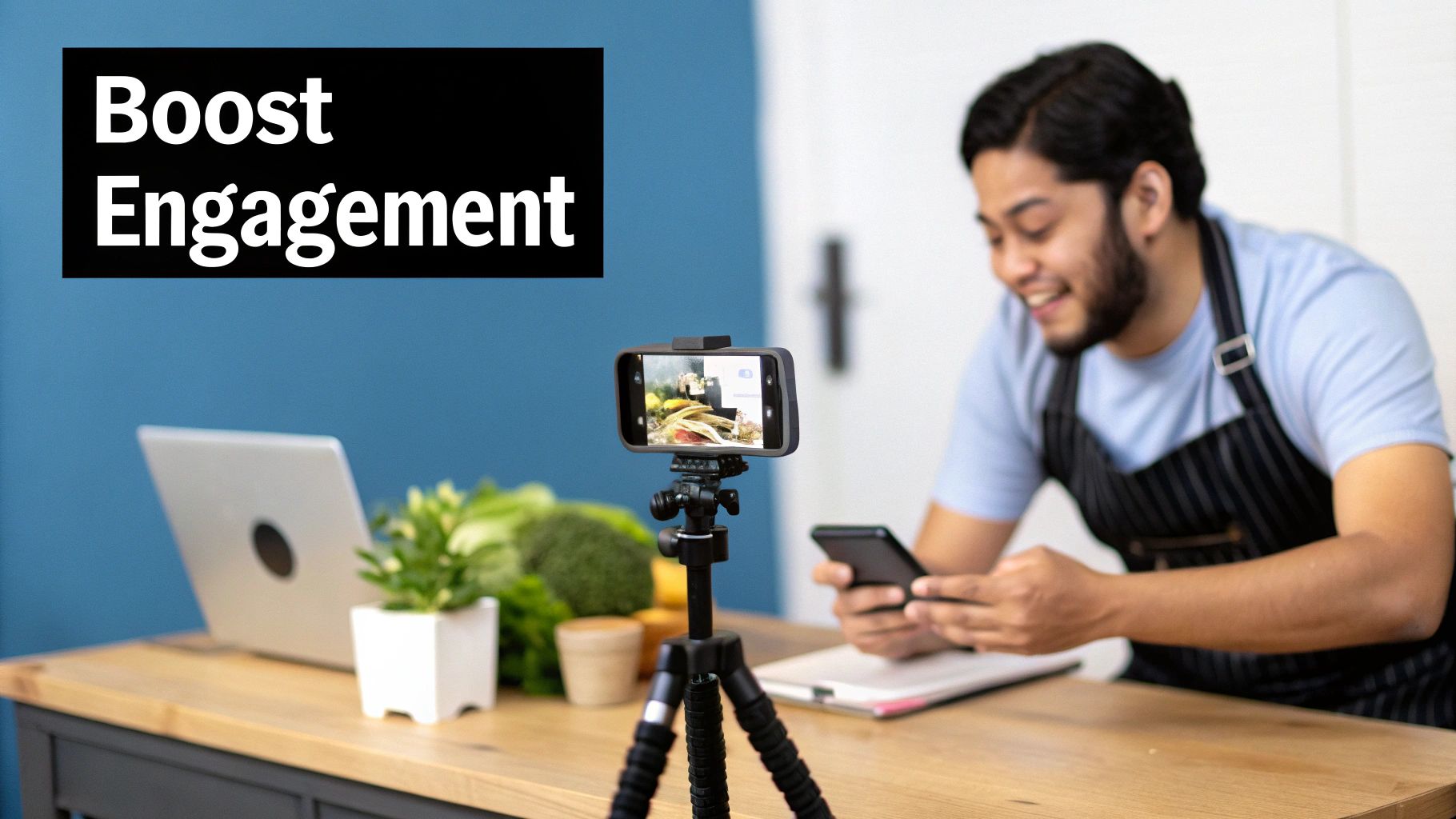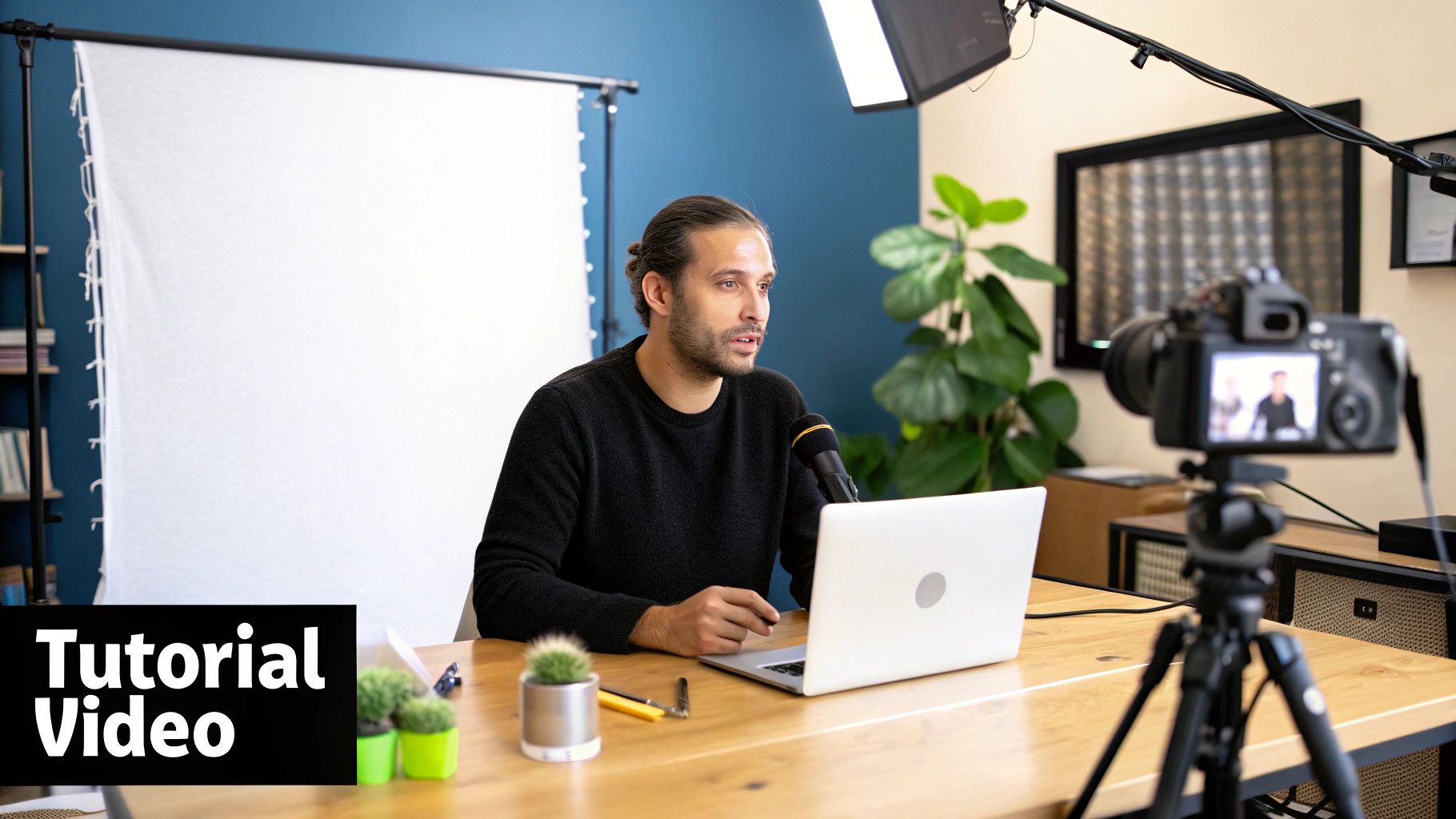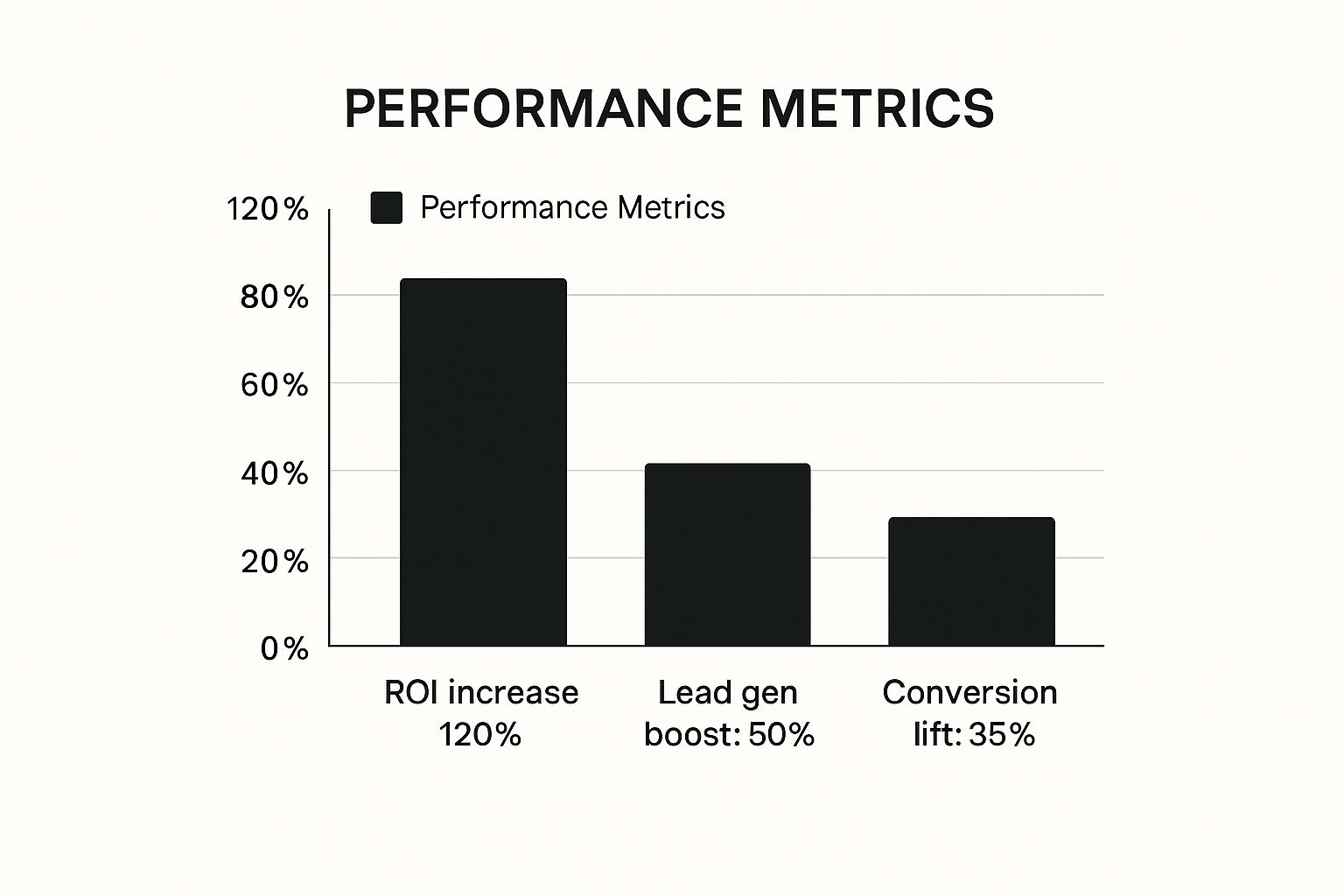
Discover video marketing for small businesses strategies that drive real growth. Learn from business owners who transformed their reach and sales.
Why Video Marketing Changes Everything for Small Businesses

Let's face it, traditional advertising feels a bit…stale. Customers see so many ads every day that they've developed a healthy skepticism. Think about it – when was the last time a banner ad or radio jingle truly resonated with you? This shift in consumer trust is exactly why video marketing for small businesses isn’t just a good idea anymore; it's essential.
Video lets you connect with your audience personally. Instead of just reading about your business, they see you, hear you, and get a sense of who you are. That builds trust, the foundation of any solid business relationship. I've spoken with so many small business owners who say video marketing has completely changed their game, and their results prove it. For example, one local bakery started posting short, behind-the-scenes videos of their team making pastries. Their engagement tripled, and they saw a real increase in new customers.
Imagine a small, handcrafted jewelry business. Static product photos are fine, but a short video showing the artisan at work, sharing their process and passion, immediately makes things more real and engaging. People buy from people they trust, and video helps create that connection in our digital world. Plus, video marketing has a compounding effect. Each video you make adds to your content library, building your reach and momentum over time.
Video marketing can genuinely transform your small business. For a deep dive into a solid growth strategy using video, check out this article on video marketing for small business. The return on investment is undeniable. Studies show that the vast majority of businesses get the power of video. By 2025, 89% of businesses were using video as a marketing tool, with 95% of video marketers calling it a key part of their strategy. Explainer videos are particularly effective, with 73% of video marketers creating them. Discover more insights.
Why Waiting is Costing You
Here’s the thing: waiting to use video marketing isn’t just missing out; it’s actually falling behind. Your competitors are probably already using video, building connections with their audience, and developing that crucial trust. Every day you wait, you’re losing potential customers and losing ground in the long run. That compounding effect of video marketing means early adopters build an advantage that gets tougher to overcome. Start small, be yourself, and see how video can change your business.
Discovering What Your Audience Actually Wants to Watch

Creating compelling video marketing for your small business really boils down to knowing your audience. Instead of throwing ideas at the wall and seeing what sticks, think of it like baking a cake. You wouldn't just toss random ingredients together, would you? You'd follow a recipe, and just like a good recipe, your videos should be tailored to your audience's tastes.
Beyond The Surface: Understanding True Engagement
I know a local bakery that learned this lesson the hard way. They thought beautiful, polished product shots were the golden ticket. Invested in all the fancy equipment, studio lighting, the works. Crickets. Engagement was totally flat.
Then, they shifted gears. Started posting quick, behind-the-scenes videos of the team prepping ingredients, sharing jokes, being themselves. Suddenly, their engagement exploded – a 300% increase. Authenticity was the secret ingredient all along. People connect with the human side of a business.
This shows the huge gap between what people say they want and what they actually watch. Surveys and focus groups have their place, sure, but real engagement metrics – your likes, shares, comments, watch time – that's your compass. They tell the real story of what's working and what's falling flat.
Spying On The Competition (The Smart Way)
Keeping an eye on the competition is important, but don't get caught in the comparison trap. The goal isn't to copy, it's to get inspired. What are they doing right? More importantly, what are they missing? Maybe everyone else is churning out super-polished, corporate-style videos. That could be your chance to create something more relatable and down-to-earth.
Imagine a consulting firm noticing all their competitors are posting formal talking-head videos. By creating something more dynamic, visually engaging, they could instantly stand out and connect with a bigger audience. Need some fresh ideas? Check out these video marketing examples from various industries.
Aligning Your Strengths With Audience Needs
Finding that sweet spot where your strengths and your audience's needs overlap is key. If you're naturally funny, let that shine through in your videos. If you're a passionate educator, create how-to videos. A retail shop owner who loves giving styling tips could create short videos showcasing how to wear their products.
This alignment not only makes creating videos more fun for you, but it also makes your content feel genuine, which is what really resonates with your audience. Remember, they're looking for something valuable and engaging. By delivering that consistently, you build trust, establish your credibility, and ultimately, grow your business. It's about making video marketing not just effective, but fulfilling, too.
To help you figure out which video styles might be the best fit for your goals, I've put together a quick comparison table:
Video Types by Business Goals
Comparison of different video types and their effectiveness for specific small business objectives
| Video Type | Best For | Average Production Time | Expected ROI |
|---|---|---|---|
| Behind-the-Scenes | Building brand authenticity and connection | Low (1-2 days) | High (Increased engagement, brand loyalty) |
| Product Demos | Showcasing product features and benefits | Medium (3-5 days) | Medium (Increased conversions) |
| Customer Testimonials | Building trust and social proof | Low (1-3 days) | High (Increased conversions, brand credibility) |
| Explainer Videos | Educating customers about complex topics | Medium (5-7 days) | Medium (Increased website traffic, lead generation) |
| How-To Tutorials | Providing valuable information and building authority | Medium (3-7 days depending on complexity) | High (Increased website traffic, brand loyalty) |
This table gives you a general idea, but remember, your mileage may vary! Experiment, see what works best for your audience, and most importantly, have fun with it!
Creating Professional Videos on a Shoestring Budget

This screenshot shows how user-friendly Canva's video editing interface is. Even if you've never edited a video before, it's surprisingly easy to navigate and create something professional-looking. Canva has pre-made templates, stock footage, and intuitive editing tools, making video creation way less intimidating than traditional methods.
Creating great video marketing for your small business doesn't have to break the bank. Honestly, some of the most effective videos out there are made with surprisingly simple equipment. I know a fitness trainer who gets way better results with smartphone videos shot in his garage than with the expensive gym commercials playing on local TV. His secret? Authenticity and real value for his viewers. He focuses on showing proper form and workout modifications, not fancy special effects.
Essential Gear vs. Budget Drainers
Let's talk equipment. Sure, high-end cameras and lighting are nice, but they're not necessary when you're just starting out. Your smartphone is a seriously powerful tool. Initially, focus your investment on a few key things that will really make a difference:
- A good tripod: Shaky footage just looks unprofessional. A stable tripod, even a budget-friendly one, instantly improves your production quality.
- A decent microphone: Clear audio is essential. People will forgive less-than-perfect visuals, but muffled audio is a no-go. A lavalier microphone (the kind that clips onto your clothing) can dramatically improve your audio for under $20.
- Basic lighting: Natural light is your best friend. Film near a window whenever possible. If you need extra light, a few affordable LED panels can work wonders.
For example, instead of splashing out on a $5,000 camera, invest $100 in a tripod, $20 in a lavalier mic, and $50 in some basic lighting. Trust me, you'll see a much better return on that $170.
Transforming Ordinary Spaces
Forget the fancy studio. Take a look around your workspace or home. A clean, uncluttered background is all you need. A bookshelf, a plain wall, even a tidy desk can work perfectly. Add a few plants or props related to your business to make it visually interesting. This is where you can get creative! Think about how you can use what you already have to create a professional look.
Lighting, Audio, and Composition Tricks
Lighting can make or break your video. Natural light is always best. Indoors, avoid overhead lighting, which creates harsh shadows. Face a window, or use soft, diffused light sources. Check out our guide on how to create video tutorials for more lighting tips.
Audio is just as important – maybe even more so. Make sure your microphone is positioned correctly for clear sound. Minimize background noise as much as possible. Watch out for wind noise if you're filming outside.
Composition is how you arrange things in the frame. The rule of thirds is a simple but effective guideline. Imagine a 3×3 grid on your screen. Positioning your subject where those lines intersect creates a more visually appealing shot.
Free Editing Tools That Deliver
You don't need expensive editing software either. There are plenty of free or inexpensive tools that get the job done. iMovie (for Mac) and DaVinci Resolve (Mac and Windows) are both great options. They have all the features you need for cutting clips, adding transitions, and including music or voiceovers. They even have basic color correction and audio mixing tools to polish your footage. You don't need a film degree to make compelling videos. With a little creativity and these practical tips, you can produce professional-looking videos that connect with your audience and boost your marketing.
Mastering Short-Form Videos That Stop the Scroll

The infographic above paints a pretty compelling picture, right? A 120% increase in ROI, a 50% boost in lead generation, and a 35% lift in conversions – those are the kinds of numbers that make short-form video marketing impossible to ignore. For small businesses, it's quickly becoming less of a "nice-to-have" and more of a "need-to-have."
Short-form video is where your audience is spending their time, and it's also where small businesses are finding real success. It's not enough to just make any videos, though. You need to create bite-sized content that grabs attention and actually moves the needle for your business. Think about those viral TikTok trends – they're short, engaging, and often introduce people to new businesses.
The Power of the Hook
You have about three seconds to make a first impression. That's your hook – the crucial opening moment that determines whether someone keeps watching or scrolls on by. A killer hook could be a surprising statistic, a thought-provoking question, or a visually striking image. Think of it like the opening line of a great song – it has to grab you instantly.
I know a local restaurant owner who started posting 30-second recipe videos. His hook? He'd show the finished dish in the first second, then rewind and show how it's made. The result? He built a following of 50,000 engaged fans and saw a 40% increase in weekend reservations.
Storytelling Formulas That Work
Some storytelling formulas just work, especially for short-form video. If you're a service business, the problem-solution-result framework is a great place to start. Highlight a common problem your customers face, present your service as the solution, and showcase the positive outcomes they can expect.
Another effective approach is the behind-the-scenes revelation. Give your audience a glimpse into how your business works, the passion behind your products, and the people who make it all happen. This builds trust and makes your brand feel more human.
Knowing the nuances of each platform is also crucial. What flies on TikTok might not work on Instagram Reels. Understanding these differences can make or break your video strategy.
Platform-Specific Nuances
Every platform has its own vibe and style. TikTok loves fast-paced, trend-driven content. Instagram Reels tends to favor visually appealing aesthetics. YouTube Shorts prefers slightly longer content with a clear narrative. Tailoring your content to each platform is essential.
To help you navigate this, I've put together a quick guide:
Platform-Specific Video Length Guidelines
Optimal video lengths and formatting requirements for major social media platforms
| Platform | Optimal Length | Maximum Length | Aspect Ratio | Key Features |
|---|---|---|---|---|
| TikTok | 15-60 seconds | 10 minutes | 9:16 | Trending sounds, fast-paced edits |
| Instagram Reels | 15-90 seconds | 90 seconds | 9:16 | Music integration, AR filters |
| YouTube Shorts | Up to 60 seconds | 60 seconds | 9:16 | Direct links, channel integration |
This table reflects the bigger trends we're seeing in video marketing for small businesses. Short-form videos, in particular, are delivering incredible ROI and attracting more investment. TikTok, for example, favors videos in the 15-60 second range, while YouTube often sees success with videos longer than 60 seconds. With 82% of marketers saying video's importance is growing, and 78% of businesses planning to create more videos, it’s clear that video is only going to become more important for small business marketing. Discover more insights.
Batch Creation for Efficiency
One last tip: don’t get stuck in a cycle of constant filming. Batch creating your content is a game-changer. Set aside a day to film multiple videos at once. This is a huge time-saver and keeps your content calendar full. Plan your outfits, locations, and scripts ahead of time to streamline the process. This frees you up to focus on other parts of your business without sacrificing consistent video output. Mastering these strategies will help you create compelling video marketing that engages your audience, builds your brand, and drives real results.
Getting Your Videos Seen by the Right People
So, you’ve created some amazing videos. That’s fantastic! But honestly, that’s only half the battle when it comes to video marketing for small businesses. The real magic happens when you get those videos in front of the right eyeballs – the people who are genuinely interested in what you're offering. It's not about being everywhere; it's about being strategic.
I remember working with a local plumbing company that was struggling to get leads. They decided to focus their video marketing efforts on just two platforms: YouTube and Facebook. They started creating how-to videos and sharing customer testimonials, targeting their local community. The results? They generated more leads in six months than in the previous three years of traditional advertising. That’s the power of targeted video marketing.
Choosing the Right Platforms
Don't fall into the trap of trying to be on every single platform. It’s a recipe for burnout and diluted effort. Instead, take a step back and figure out where your ideal customers are actually hanging out online. Are they active in Facebook groups? Are they constantly watching YouTube tutorials? Are they obsessed with Instagram Reels?
Your audience should dictate your platform strategy, not the latest social media trend. For instance, mastering short-form video often means using Instagram Reels effectively. If that's where your audience is, check out this resource on Instagram Reels for Business. It's a game-changer.
This focused approach is so much more effective than spreading yourself thin. It allows you to tailor your content to each specific platform and build deeper relationships with your audience. Remember: quality over quantity. It's better to have a strong presence on a couple of key platforms than a weak presence everywhere.
Cross-Promotion and Integration Strategies
Once you've picked your platforms, think about how you can cross-promote your videos. I’m not talking about spamming links everywhere. It’s about creating a natural flow between your online presence.
For example, embed your YouTube videos in your website blog posts. Share snippets of your longer videos as teasers on Instagram, linking back to the full version on YouTube. Mention your videos in your email newsletters. I’ve seen this kind of email integration boost video views by a whopping 200%. Also, take a look at this article on optimizing video for lead generation. It's packed with useful tips.
Website Optimization for Video
Your website is your online home base – make sure your videos are front and center. Don't bury them on a hidden page. Feature them prominently on your homepage, product pages, and even your "About Us" section.
Optimize your video titles and descriptions with relevant keywords so they show up in search results. And don’t forget to make sure your website is mobile-friendly! A huge percentage of video viewing happens on smartphones. These simple tweaks can make a big difference in turning casual browsers into engaged prospects.
Community Management: Building Loyal Advocates
Finally, never underestimate the power of community. Engage with the comments on your videos. Answer questions. Respond to feedback. This is how you build a loyal following who not only watch your videos, but also become enthusiastic advocates for your business.
I’ve seen small business owners turn one-time viewers into passionate brand ambassadors simply by taking the time to build genuine connections. This authentic engagement is what translates into real, sustainable growth. Remember, it’s not just about views; it's about building a thriving community around your brand.
Tracking What Matters and Growing Strategically
Vanity metrics are like that friend who's all talk and no action. Sure, thousands of views or likes can stroke your ego, but they won't pay the bills. As a small business owner dabbling in video marketing, you need to focus on the metrics that actually mean something – the ones that translate into real business growth. I've been there, chasing those shiny vanity metrics, and let me tell you, it's a quick way to drain your marketing budget.
Setting Up Simple Tracking with Free Tools
Don’t worry, you don't need some fancy analytics dashboard to get valuable insights. Free tools like YouTube Analytics and the built-in analytics on platforms like Facebook and Instagram are surprisingly powerful. Just start by tracking these key metrics:
- Watch time: Forget view count, watch time is where it's at. This tells you how long people are actually watching, which is a much better indicator of engagement.
- Audience retention: This shows you where people are dropping off, like breadcrumbs leading you to areas for improvement in your content.
- Click-through rate (CTR): This measures how effective your calls to action are. Are people clicking through? If not, it's time to revisit those CTAs.
- Conversion rate: This is the holy grail of metrics. Are viewers taking the action you want them to take? Signing up? Making a purchase? This tells you whether your videos are actually driving results.
Setting up tracking is usually a breeze – just a few clicks within the platform itself. These free tools offer a goldmine of information without burying you in data you'll never use.
Interpreting Analytics and Making Smart Decisions
Let me paint you a picture. You've got a video with 10,000 views but only a 10% average watch time. People are clicking, but they’re bouncing faster than a rubber ball. Now, imagine another video with 1,000 views and a 70% average watch time. Those 1,000 viewers are way more valuable. They’re engaged, interested, and much more likely to become customers. This highlights why targeted views trump a massive reach with low engagement.
Think of it like fishing. Casting a wide net might bring in a lot of something, but is it the right something? Targeted videos are like using the perfect bait to attract the right kind of fish – your ideal customers.
By looking at watch time, audience retention, and CTR, you can get inside your viewers' heads. You’ll understand what resonates with them and make smarter decisions about your future content. For instance, if viewers are consistently bailing at a certain point, that’s a clear sign to tweak your pacing or messaging.
Scaling Your Video Efforts and ROI
When your video marketing starts to gain traction, you’ll naturally want to scale things up. Maybe invest in better equipment, hire an editor, or expand to new platforms. But hold your horses! Let your data be your guide.
If your videos are doing well with simple smartphone footage, don't rush out to buy a professional camera. Instead, consider putting that money toward promoting your high-performing videos to a larger, targeted audience.
Hiring help can be a game-changer, but only if it allows you to focus on what you excel at – connecting with your audience and building your business. Don't outsource tasks you love just because you think you "should." Prioritize scaling activities that have a direct impact on your ROI.
Expanding to new platforms is exciting, but don’t spread yourself too thin. Use your data to find out where your target audience hangs out online and choose platforms strategically. This focused approach ensures you continue to grow your video marketing effectively, without sacrificing quality or burning yourself out.
Your Video Marketing Implementation Roadmap
Alright, let's ditch the jargon and get practical. You've learned a lot about video marketing for small businesses, but now it's time to tailor a roadmap that fits your specific needs. Remember, you're running a business, not a major film studio. We're talking achievable steps, not a Hollywood blockbuster production.
Your First 30 Days: Building a Foundation
The first month is all about laying the groundwork. Pick one or two social media platforms where your ideal customer spends their time. Don't spread yourself too thin trying to be everywhere at once. Start with a simple content plan. Think three or four short, impactful videos. Remember that bakery example I mentioned? Behind-the-scenes glimpses can be surprisingly effective. What quick wins can you score with minimal effort? Focus on quality over quantity. Even one polished video can make a huge difference.
Days 30-60: Refining and Expanding
Once you've got a few videos out there, take a look at what's resonating. Which ones are getting the most views, likes, and comments? What kind of feedback are you receiving? Use this information to fine-tune your content strategy. Play around with different video styles and topics. Now's the time to start adding a call to action. Guide viewers to your website, email list, or product pages. Start cross-promoting your videos on other platforms, too. Share snippets on social media, embed them in blog posts, and include them in your email newsletters.
Days 60-90: Systemizing and Scaling
By this point, you should have a pretty good handle on what your audience loves. Now it's about building a system you can maintain. Create a content calendar to schedule your video production. Try batch filming to save time and effort – I've found this incredibly helpful. Think about repurposing your existing content. Could a longer video be chopped into shorter clips for social media? Could you create blog posts based on your video content? Start tracking important metrics like watch time and click-through rate. This data is gold for making smart decisions about future content and expanding to new platforms.
Overcoming Common Obstacles
One trap many fall into is perfectionism. Don't get stuck trying to make every video absolutely perfect. Finished is better than flawless, particularly when you're starting out. Another challenge is inconsistent posting. A content calendar and batch filming can really help with this. Consistency builds momentum and keeps your audience coming back for more.
Ready to take your video marketing to the next level? VideoQi's interactive video platform helps you create engaging, personalized video experiences that convert viewers into customers. Explore VideoQi today and see how to maximize your video marketing impact.


